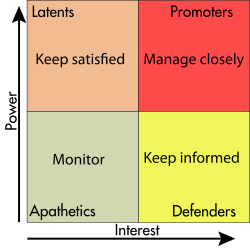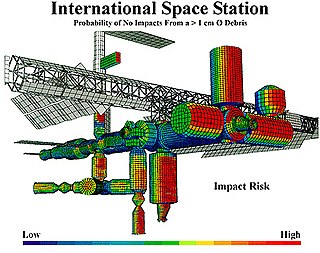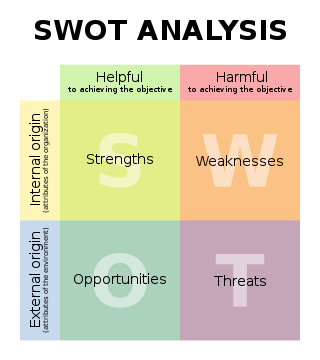Stakeholder mapping

The following list identifies some of the best known and most commonly used methods for stakeholder mapping:
- Cameron et al. defined a process for ranking stakeholders based on needs and the relative importance of stakeholders to others in the network. [6]
- Mitchell et al. proposed a classification of stakeholders based on power to influence, the legitimacy of each stakeholder's relationship with the organization, and the urgency of the stakeholder's claim on the organization. The results of this classification may assess the fundamental question of "which groups are stakeholders deserving or requiring manager's attention, and which are not?" This is salience – "the degree to which managers give priority to competing stakeholder claims." [7]
- Savage et al. offer a way to classify stakeholders according to potential for threat and potential for cooperation. [8]
- Turner et al. have developed a process of identification, assessment of awareness, support, and influence, leading to strategies for communicating and assessing stakeholder satisfaction, and determining who is aware or ignorant and whether their attitude is supportive or opposing. [9]
Mapping techniques include the following analysis techniques being used by aid agencies, governments, or consultant groups:
- Imperial College London's influence-interest grid, "plotting stakeholders on a graph in terms of their influence over the project and their interest in the project" [10]
- The former Office of Government Commerce's power-impact grid, mapping "the level of impact of the change on [stakeholder] and the importance these stakeholders [have] to the success of the change project". [11]
[12] The 3i framework provides a structured approach to stakeholder mapping by identifying key actors based on their interests, influence, and potential impact on decision-making processes. This method has been effectively used to prioritize stakeholders in complex environmental and governance contexts.
Stakeholder mapping procedure
The list of potential stakeholders for any project often exceeds both the time available for analysis and the capability to sensibly map and display the results. [13] The challenge is to focus on the right stakeholders who are currently important and to create a visual representation of this critical sub-set of the total community - the key stakeholders. [13]
The power-interest matrix
The most common presentation style uses a two-dimensional matrix. Power and influence are commonly seen with a third dimension shown by the colour or size of the symbol representing the individual stakeholders, often the attitude.
Some of the commonly used dimensions include: [4] [15] [16] [10] [11] [14]
- Power (high, medium, low)
- Influence (high or low)
- Interest/Need (high, medium, low)
- Support/Attitude (positive, neutral, negative)
The salience model
The salience model [7] uses three dimensions: legitimacy (A), power (B), and urgency (C). It is represented in a Venn diagram with eight regions, each associated with a specific stakeholder type.

Stakeholder types as described by the salience model:
- Discretionary stakeholders: These stakeholders have little urgency or power and are unlikely to exert much pressure. They have legitimate claims. (yellow region)
- Dormant stakeholders: These stakeholders have much power but no legitimacy or urgency and therefore are not likely to become heavily involved. (blue region)
- Demanding stakeholders: These stakeholders have little power or legitimacy but can make much "noise" because they want things to be addressed immediately. (red region)
- Dominant stakeholders: These stakeholders have both formal power and legitimacy, but little urgency. They tend to have certain expectations that must be met. (green region)
- Dangerous stakeholders: These stakeholders have power and urgency but are not really pertinent to the project. (purple region)
- Dependent stakeholders: These stakeholders have urgent and legitimate stakes in the project but little power. These stakeholders may lean on another stakeholder group to have their voices heard. (orange region)
- Definitive stakeholders: These stakeholders have power, legitimacy and urgency and therefore have the highest salience. (white region at the intersection of all other regions)
- Non-stakeholders: These stakeholders have no power, legitimacy or urgency. (outside the regions defined by the circles A, B, and C)




